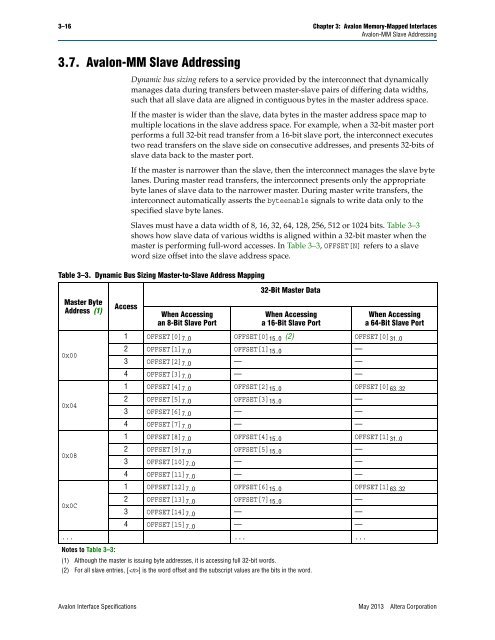Avalon Interface Specifications (PDF) - Altera
Avalon Interface Specifications (PDF) - Altera
Avalon Interface Specifications (PDF) - Altera
Create successful ePaper yourself
Turn your PDF publications into a flip-book with our unique Google optimized e-Paper software.
3–16 Chapter 3: <strong>Avalon</strong> Memory-Mapped <strong>Interface</strong>s<br />
<strong>Avalon</strong>-MM Slave Addressing<br />
3.7. <strong>Avalon</strong>-MM Slave Addressing<br />
Dynamic bus sizing refers to a service provided by the interconnect that dynamically<br />
manages data during transfers between master-slave pairs of differing data widths,<br />
such that all slave data are aligned in contiguous bytes in the master address space.<br />
If the master is wider than the slave, data bytes in the master address space map to<br />
multiple locations in the slave address space. For example, when a 32-bit master port<br />
performs a full 32-bit read transfer from a 16-bit slave port, the interconnect executes<br />
two read transfers on the slave side on consecutive addresses, and presents 32-bits of<br />
slave data back to the master port.<br />
If the master is narrower than the slave, then the interconnect manages the slave byte<br />
lanes. During master read transfers, the interconnect presents only the appropriate<br />
byte lanes of slave data to the narrower master. During master write transfers, the<br />
interconnect automatically asserts the byteenable signals to write data only to the<br />
specified slave byte lanes.<br />
Slaves must have a data width of 8, 16, 32, 64, 128, 256, 512 or 1024 bits. Table 3–3<br />
shows how slave data of various widths is aligned within a 32-bit master when the<br />
master is performing full-word accesses. In Table 3–3, OFFSET[N] refers to a slave<br />
word size offset into the slave address space.<br />
Table 3–3. Dynamic Bus Sizing Master-to-Slave Address Mapping<br />
Master Byte<br />
Address (1)<br />
Access<br />
When Accessing<br />
an 8-Bit Slave Port<br />
32-Bit Master Data<br />
When Accessing<br />
a 16-Bit Slave Port<br />
When Accessing<br />
a 64-Bit Slave Port<br />
1 OFFSET[0] 7..0 OFFSET[0] 15..0 (2) OFFSET[0] 31..0<br />
0x00<br />
2<br />
3<br />
OFFSET[1] 7..0<br />
OFFSET[2] 7..0<br />
OFFSET[1] 15..0<br />
—<br />
—<br />
—<br />
4 OFFSET[3] 7..0 — —<br />
1 OFFSET[4] 7..0 OFFSET[2] 15..0 OFFSET[0] 63..32<br />
0x04<br />
2<br />
3<br />
OFFSET[5] 7..0<br />
OFFSET[6] 7..0<br />
OFFSET[3] 15..0<br />
—<br />
—<br />
—<br />
4 OFFSET[7] 7..0 — —<br />
1 OFFSET[8] 7..0 OFFSET[4] 15..0 OFFSET[1] 31..0<br />
0x08<br />
2<br />
3<br />
OFFSET[9] 7..0<br />
OFFSET[10] 7..0<br />
OFFSET[5] 15..0<br />
—<br />
—<br />
—<br />
4 OFFSET[11] 7..0 — —<br />
1 OFFSET[12] 7..0 OFFSET[6] 15..0 OFFSET[1] 63..32<br />
0x0C<br />
2<br />
3<br />
OFFSET[13] 7..0<br />
OFFSET[14] 7..0<br />
OFFSET[7] 15..0<br />
—<br />
—<br />
—<br />
4 OFFSET[15] 7..0 — —<br />
... ... ...<br />
Notes to Table 3–3:<br />
(1) Although the master is issuing byte addresses, it is accessing full 32-bit words.<br />
(2) For all slave entries, [] is the word offset and the subscript values are the bits in the word.<br />
<strong>Avalon</strong> <strong>Interface</strong> <strong>Specifications</strong> May 2013 <strong>Altera</strong> Corporation
















